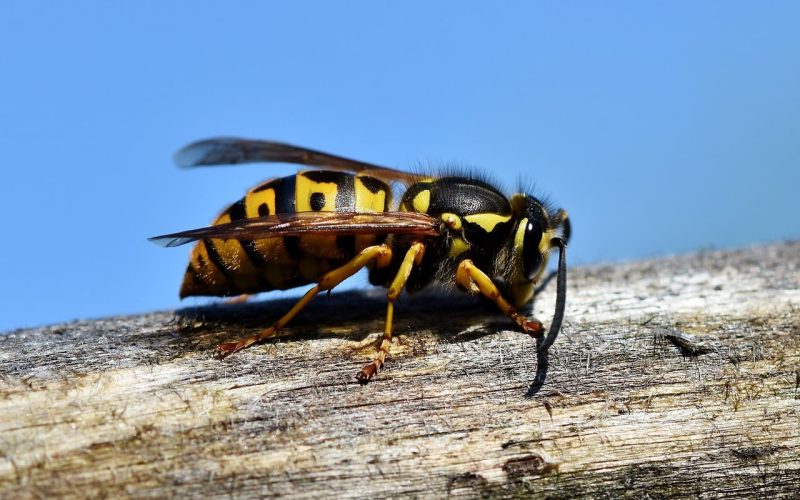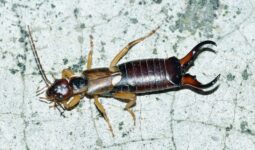Wasps are sociable insects that belong to the order Hymenoptera and the suborder Apocrita, some of which are stinging insects.
Sometimes, this insect may find its way into your home, and it becomes normal to seek ways to get a wasp out of your house.
There are various types of wasps worldwide, and they can be found everywhere except for Antarctica.
Some are brightly colored black & yellow/orange with a slender waist and a nasty stinger that protrudes from their abdomen.
They are generally more aggressive than bees and will readily attack you if their nests are disturbed or they feel threatened.
Furthermore, unlike Bees, wasps can sting their victims multiple times in one attack since they do not lose their stinger after stinging.
Because of this, people tend to avoid wasps at all costs. Wasp stings hurt and can be dangerous.
Their sting can be painful, and some people may suffer an allergic reaction, the most severe being anaphylaxis.
Besides stinging family, friends, and us, Wasp may also sting pets.
According to the Centers for Disease Control and Prevention (CDC), 1,109 people died from wasp and bee stings between 2000 and 2017, or an annual average of 62 deaths.
This shows that wasps can sometimes be dangerous even though they are part of the ecosystem with their importance.
Oh yes! Just like the bees, wasps also play a role in pollinating crops and flowers. They are beneficial in controlling pest populations.
They eat other insects and provide food for many species of birds here. Killing them when they invade our homes should be a last resort.
Apart from their death affecting the ecosystem, wasps emit chemicals when they die, which is a communication mechanism.
If other wasps are in the area, it will alert them that a comrade has fallen and make them more aggressive, which may lead to attacks.
Nevertheless, safety should be our first concern, so this article will examine how to get a wasp out of your house.
How Do Wasps Get In The House?
Before we tackle the issue of how to get a wasp out of your house, it behooves us to ascertain how they got into the house in the first place.
Like all living things, shelter and food are just one of the primary reasons they enter our homes.
They also find their way into our homes in several ways.
- Through open doors or windows. Wasps may build their homes around windows and doors because the frames protect them from rain, heat, and other weather. Opening a door or window with a small hole gives the wasps enough time to enter the house.
- Wasps may also enter the home through the attic. Attics are dark and may protect from the elements of the wasp. They may also have openings through vents where the roof meets the structure; wasps can come through them. Besides, the wasp may create colonies in the attic, where they go out during the day and return at night.
- Another entrance point for wasps is through exhaust vents in the bathroom or laundry room when the flap of the exhaust vent is broken or damaged.
- The fireplace is also another entry point for a wasp. Besides, they may find a hole in the chimney and enter that way.
So, these are some ways a wasp may find itself in our home. It may seem harmless, but you may also get stung without warning.
The point remains to get them out as soon as possible when we find them.
How to Get a Wasp Out of Your House
1. Locate the Wasp and Create an Exit by Opening Doors and Windows
To get rid of the wasp, assess the situation and determine where it is. After locating the wasp, stay calm, even if it’s buzzing about you.
They are unlikely to attack you if you remain calm. Stay calm, keep your eyes on it, and track its movement.
At this point, your priority is to lead it outside your house, so don’t try to swat it.
Swatting the wasp may kill it, and you don’t want a dead wasp while your windows and doors are open. Its death releases a pheromone, which attracts nearby wasps.
This chemical is like a call for backup. While the doors are open, the nearby wasp comrade may enter your house intending to attack, and you have to start dealing with another invader.
So, avoid swatting, stay calm, and the wasp may find its way outside. If it fails to leave, you can switch on the fan.
Wasps are not built to navigate high winds. So, you can use the fan on a fast but cool setting to divert the wasp back outside.
Another way to encourage the wasp to leave your house is to use mint. Oh yes! The wasp doesn’t like the scent of mint.
By the time they perceive this, they will go immediately. You could mix peppermint oil and water here and spray it near the wasp to encourage it to leave your house.
After the wasp leaves, do not hesitate to seal the doors and windows.
Whenever you decide to open the windows on a pleasant day, keep the screen closed and ensure no holes in your screen to prevent any wasps from flying in.
Examine your property, check for possible entry points the wasp utilized, and deal with them. You can check for unsealed vents, torn screens, and cracks around windows and door frames.
You can also use caulk to fill small gaps around your property to prevent wasps from entering your home again.
2. Use Wasp Traps
Another method to get a wasp out of your house is a wasp trap.
Does it sound surprising? They are wasp traps. The trap has a liquid that attracts wasps.
When the wasps get attracted and crawl into the trap, they get stuck and drown.
You can get a wasp trap from the local pesticide store, make one yourself, or even from an online store like Amazon.
Making a wasp trap is quite simple. All you need are the following;
- Scissors or a razor blade
- Empty plastic bottle (2L)
- Tape
- Bait (you can use soda or fruit juice watered down with a few drops of liquid dish soap. You could also use jam, sugar water, or something sweet to attract the wasp. For added strength, you can add a little vinegar on the neck so the wasp can’t escape the trap)
To make this trap:
- Use your razor or scissors to cut the bottle a third down.
- Add a few inches of your bait to the bottom of the bottle.
- Remove the bottle cap in an inverted pyramid form, turn the top third of the bottle, and attach the neck to the bottom part you cut.
- Then, tape the two bottle pieces together and place them in the areas of your home suspected of wasp activity.
The bait will attract the wasps; they will fly in and have trouble getting out. You can set this trap in the areas suspected of wasp activities.
Better still, you can heat two ends of a wire, stick the wire into either side of the bottle, and hang it in the areas of wasp activities.
Now you have your trap, so ensure you empty it consistently.
They don’t make a good sight when they accumulate dead wasps, and besides, too many dead wasps provide a kind of raft or support for other wasps to survive on in the trap’s bottom.
3. Use Pesticide to Remove Them
Using pesticides is another effective mechanism for getting a wasp out of your house. It is important to note that pesticides kill the wasp.
You can buy a wasp-killing spray at your grocery store or online to deal with the wasps.
Before using the pesticide, cover food, clothing, or bedding, and remove children or pets from the room before you spray.
Wasp sprays unleash powerful wasp-killing pyrethroids and pyrethrins from a relatively safe distance. The spray works on contact, hastily killing the wasps with potent neurotoxin.
Follow the directions on the insecticide you buy and spray the wasp with the pesticide as you see it coming. So long as you hit the wasp, the spray will kill them.
If you want to avoid pesticides, you can make your own wasp killer, apart from the store-bought pesticide. One such method is the use of a soap and water solution.
Mix two tablespoons of liquid soap and water in a spray bottle to do this. Spray the wasp.
The soap bogs down the wasp, clogs its breathing pores, and suffocates it instantly.
Other homemade remedies are water, witch hazel, and peppermint essential oil.
To do this:
- Fill the spray bottle with half water and half witch hazel.
- Add 30-50 drops of peppermint essential oil.
- Shake it together and spray it on the wasp in your home as it arrives. The peppermint oil will stick to the wasp, making it difficult to fly and eventually leading to its demise.
4. Eliminate the Wasp Net
Sometimes, killing the wasp or chasing it outside the house may not eliminate it if it has comrades in your home.
So, the trick is figuring out if it’s just a lone wasp or has taken shelter in your home. If that is the case, it is time to eliminate their abode.
Before you remove the nest, kill the wasp first so they won’t build a nest elsewhere in your home. Removing the nest can also be tricky and challenging.
Wear protective clothing and spray the nest in the evening for effective and easy removal.
This is the ideal time when the wasps are less aggressive, and the workers and queen are all present.
Spray the nest with store-bought pesticide for at least 24 hours before trying to remove it. Do not use the typical DIY solution above.
The homemade solution is only suitable for one or two wasps, not a colony.
The 24-hour time frame is enough to determine whether a wasp survivor exists.
If you still see wasp activity, respray the nest and wait another 24 hours to assess the situation.
Once the wasps are gone, you can safely remove the nest and toss it in the garbage. This is just one way to get a wasp out of your house.
5. Call a Professional
Dealing with the wasp menace can be daunting and time-consuming. You have tried what you can and can’t get the wasp out of your house.
You should call a professional to avoid the risk, especially when dealing with a nest in a hard-to-reach area.
The professionals have the proper materials and protective equipment to quickly and safely remove wasps.
Calling a professional is a great tactic to get a wasp out of your house.
Conclusion
Getting rid of wasps can be challenging because of the risk of getting stung. So far, we have examined how to get a wasp out of your house.
Some methods explored in this article are locating the wasp and creating an exit by opening doors and windows, using wasp traps, and using pesticides.
Eliminating the wasp nest is also an ideal technique. We also considered the option of calling a professional.
After getting the wasps out of your house, seal their entry points, as we stated earlier, to prevent future entry.
Remove food sources like overripe fruits, open sugary substances, and garbage.
To keep the wasps away, you can also plant or pot some wasp-repellent plants around your porch, window, or doorways, like marigold, wormwood, pennyroyal, mint, basil, and geranium.








